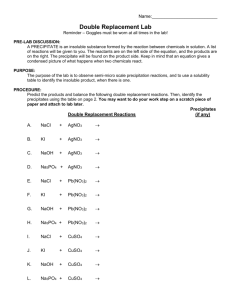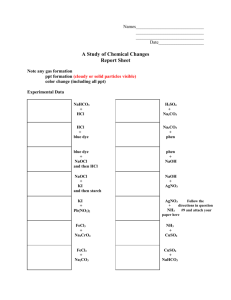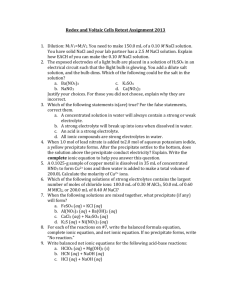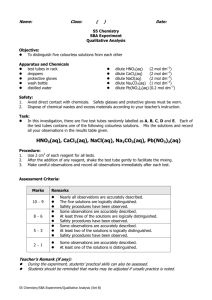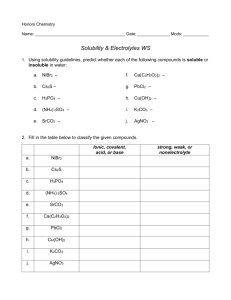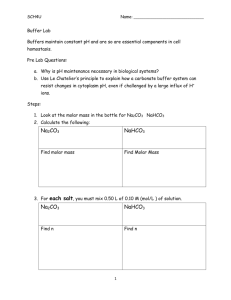Mystery Solutions
advertisement
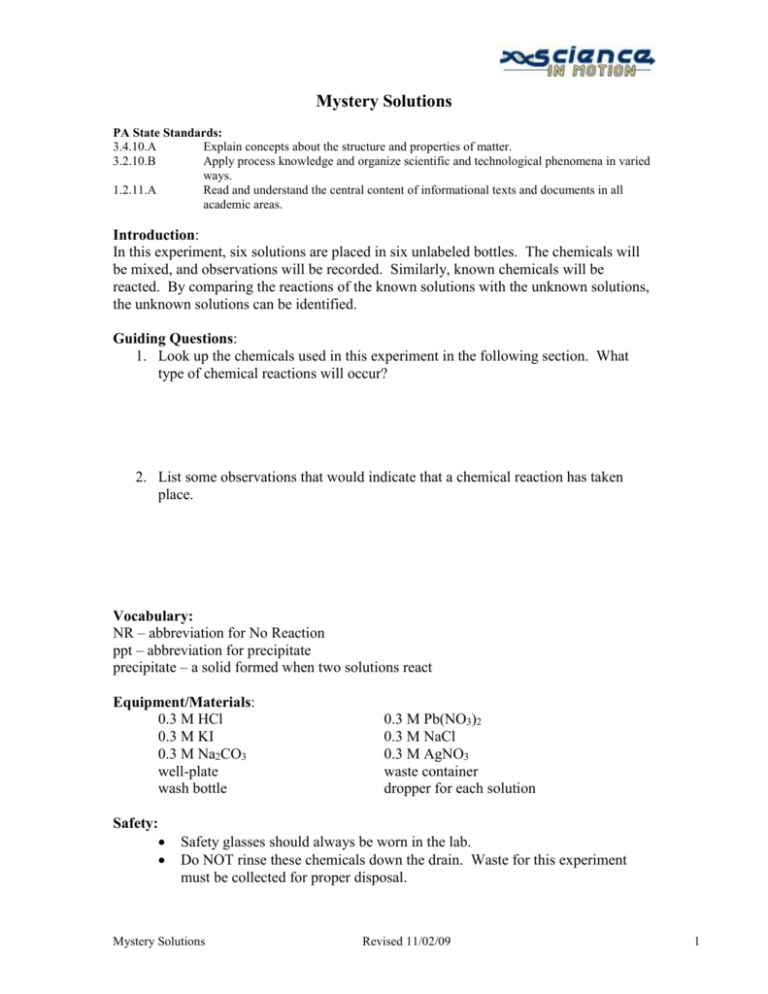
Mystery Solutions PA State Standards: 3.4.10.A Explain concepts about the structure and properties of matter. 3.2.10.B Apply process knowledge and organize scientific and technological phenomena in varied ways. 1.2.11.A Read and understand the central content of informational texts and documents in all academic areas. Introduction: In this experiment, six solutions are placed in six unlabeled bottles. The chemicals will be mixed, and observations will be recorded. Similarly, known chemicals will be reacted. By comparing the reactions of the known solutions with the unknown solutions, the unknown solutions can be identified. Guiding Questions: 1. Look up the chemicals used in this experiment in the following section. What type of chemical reactions will occur? 2. List some observations that would indicate that a chemical reaction has taken place. Vocabulary: NR – abbreviation for No Reaction ppt – abbreviation for precipitate precipitate – a solid formed when two solutions react Equipment/Materials: 0.3 M HCl 0.3 M KI 0.3 M Na2CO3 well-plate wash bottle Safety: 0.3 M Pb(NO3)2 0.3 M NaCl 0.3 M AgNO3 waste container dropper for each solution Safety glasses should always be worn in the lab. Do NOT rinse these chemicals down the drain. Waste for this experiment must be collected for proper disposal. Mystery Solutions Revised 11/02/09 1 Science in Motion Juniata College Procedure: Be careful not to contaminate the droppers! Do not touch the dropper to the well-plate or to any liquid in the well-plate. 1. Place a well-plate on a piece of white paper to make any reaction more visible. 2. Place two or three drops of a known chemical in a well. Add two or three drops of another known chemical to the same well. 3. Record your observations in the appropriate location on the Known Chemical Data Table. Be descriptive! Also record the well number used. 4. Repeat steps 1 and 2 with all combinations so that the Known Chemical Data Table is completely filled. 5. Take your well-plate to the appropriate container to dispose of the waste. Rinse the well-plate into the container with a small amount of water from a wash bottle. Do NOT contaminate the wash bottle! 6. Clean your well-plate completely in the sink using hot water, if possible. Use a test tube brush when necessary. 7. Repeat this procedure with the unknown chemicals so that the Unknown Chemical Data Table is completely filled. 8. Properly dispose of your waste as before, and then clean your well-plate thoroughly. Mystery Solutions Revised 11/02/09 2 Science in Motion Juniata College Known Chemical Data Table HCl AgNO3 Na2CO3 NaCl Pb(NO3)2 KI HCl well # AgNO3 well # Na2CO3 well # NaCl well # Pb(NO3)2 well # KI well # Mystery Solutions Revised 11/02/09 3 Science in Motion Juniata College Unknown Chemical Data Table A B C D E F A well # B well # C well # D well # E well # F well # Mystery Solutions Revised 11/02/09 4 Science in Motion Juniata College Questions: 1. Predict the products for the chemical reactions below. Balance the reactions. HCl + AgNO3 → HCl + Na2CO3 → HCl + NaCl HCl + Pb(NO3)2 HCl + KI → → → → AgNO3 + Na2CO3 AgNO3 + NaCl AgNO3 + Pb(NO3)2 AgNO3 + KI Na2CO3 + NaCl Na2CO3 + Pb(NO3)2 Na2CO3 + KI Mystery Solutions → → → → → → Revised 11/02/09 5 Science in Motion Juniata College NaCl + Pb(NO3)2 NaCl + KI Pb(NO3)2 → → + KI → 2. Look up the solubility rules in your textbook. Which of the products in the reactions above will form a precipitate? Put (↓) beside those products that will precipitate. 3. Were any gases produced? Why? 4. On the Known Chemical Data Table, mark all of the reactions that should have formed a precipitate. Were there any discrepancies between your data and the precipitates you expected? 5. Compare the reactions of the known and unknown chemicals. Identify the unknown chemicals below. Unknown A __________________________ Unknown B __________________________ Unknown C __________________________ Unknown D __________________________ Unknown E __________________________ Unknown F __________________________ 6. Write the complete ionic equation and the net ionic equation for all of the reactions in this experiment. Mystery Solutions Revised 11/02/09 6

